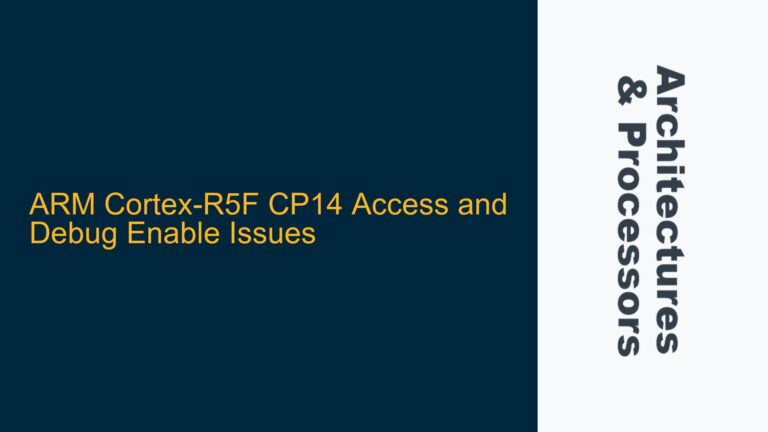ARM Mali C71AE Performance Counters: Absence of Thread-Level Metrics
The ARM Mali C71AE Image Signal Processor (ISP) is a highly optimized IP block designed for real-time image processing, capable of delivering one pixel per clock cycle under ideal conditions. However, when integrating the Mali C71AE into a larger SoC, particularly within a video processing subsystem, understanding the actual performance of the ISP becomes critical. The primary challenge lies in the absence of dedicated hardware performance counters within the Mali C71AE that can provide thread-level metrics. This limitation complicates the task of measuring the effective bandwidth and overall performance of the ISP subsystem, especially when considering the AXI input and output interfaces.
The Mali C71AE Register Map (r1p2-00eac0) does not explicitly document registers for performance counters that track pixel processing over time. This omission is significant because it prevents direct measurement of the ISP’s throughput in terms of pixels processed per unit time. Without such counters, it becomes difficult to correlate the theoretical performance of one pixel per clock with the actual performance observed in a real-world system, where factors like AXI bus contention, memory latency, and bandwidth limitations can significantly impact the ISP’s efficiency.
The absence of thread-level performance counters also hinders the ability to diagnose performance bottlenecks at a granular level. In a multi-threaded environment, where the Mali C71AE may be processing multiple image streams concurrently, understanding the performance of individual threads is crucial for optimizing the system. Without these metrics, engineers must rely on indirect methods, such as monitoring AXI interface activity, to infer the ISP’s performance. This approach, while feasible, introduces additional complexity and may not provide the level of detail required for fine-tuning the system.
Memory Bandwidth Constraints and AXI Interface Saturation
The performance of the ARM Mali C71AE ISP is inherently tied to the bandwidth of its AXI input and output interfaces. Even though the ISP is capable of processing one pixel per clock, the actual throughput may be limited by the available memory bandwidth. The AXI interfaces serve as the primary communication channels between the ISP and the rest of the SoC, including the memory subsystem. If these interfaces become saturated due to high traffic from other IP blocks or inefficient memory access patterns, the ISP’s performance will degrade.
One possible cause of AXI interface saturation is inefficient data transfer scheduling. The Mali C71AE relies on the AXI protocol to fetch input image data and write processed output data. If the AXI transactions are not optimized for the ISP’s access patterns, the interface may experience contention, leading to increased latency and reduced throughput. For example, if the ISP frequently accesses non-contiguous memory regions, the AXI bus may incur additional overhead due to address translation and arbitration, further exacerbating bandwidth constraints.
Another potential cause is the lack of adequate buffering within the Mali C71AE. While the ISP is designed to process one pixel per clock, it may not have sufficient internal buffers to handle bursts of data efficiently. If the AXI interface cannot supply data at the required rate, the ISP may stall, leading to underutilization of its processing capabilities. This issue is particularly relevant in systems where the memory subsystem is shared among multiple IP blocks, each competing for bandwidth.
The configuration of the AXI bus fabric also plays a critical role in determining the ISP’s performance. The bus fabric must be designed to prioritize AXI transactions from the Mali C71AE to ensure that it receives the necessary bandwidth. However, achieving this prioritization without negatively impacting other IP blocks requires careful tuning of the bus fabric’s arbitration policies. If the arbitration policies are not optimized, the ISP may experience intermittent delays, leading to inconsistent performance.
Implementing AXI Performance Counters and Bandwidth Optimization Strategies
To address the challenges posed by the absence of thread-level performance counters in the ARM Mali C71AE, engineers can implement AXI performance counters at the input and output interfaces of the ISP. These counters can track key metrics such as the number of AXI transactions, the amount of data transferred, and the latency of each transaction. By correlating these metrics with the ISP’s internal clock cycles, engineers can estimate the effective throughput of the ISP and identify potential bottlenecks.
The implementation of AXI performance counters requires careful consideration of the AXI protocol’s features. The AXI protocol supports multiple channels for address, data, and control signals, each of which must be monitored independently. Engineers should configure the counters to capture both read and write transactions, as the ISP’s performance depends on both fetching input data and writing output data. Additionally, the counters should be designed to handle burst transactions efficiently, as the Mali C71AE is likely to use burst transfers to maximize bandwidth utilization.
Once the AXI performance counters are in place, engineers can use the collected data to optimize the AXI bus fabric and memory subsystem. For example, if the counters reveal that the ISP is frequently stalled due to AXI interface contention, engineers can adjust the bus fabric’s arbitration policies to prioritize the ISP’s transactions. Similarly, if the counters indicate that the ISP is experiencing high latency during memory accesses, engineers can optimize the memory controller’s scheduling algorithms to reduce latency.
Another optimization strategy involves increasing the Mali C71AE’s internal buffering capacity. By adding more buffers, the ISP can handle bursts of data more efficiently, reducing the likelihood of stalls due to AXI interface saturation. This approach requires careful analysis of the ISP’s access patterns to determine the optimal buffer size and configuration. Engineers should also consider the impact of additional buffering on the ISP’s power consumption and area footprint, as these factors may influence the overall design trade-offs.
In addition to AXI performance counters, engineers can leverage simulation tools to model the Mali C71AE’s behavior under different AXI bus configurations. These tools can provide insights into the ISP’s performance under various traffic scenarios, helping engineers identify potential bottlenecks before the design is finalized. By combining simulation results with data from the AXI performance counters, engineers can develop a comprehensive understanding of the ISP’s performance characteristics and implement targeted optimizations.
Finally, engineers should consider the impact of the Mali C71AE’s configuration on its performance. The ISP’s performance may vary depending on the specific image processing algorithms being used, as well as the resolution and frame rate of the input images. By tuning the ISP’s configuration parameters, such as the number of active threads and the size of the processing windows, engineers can maximize its throughput while minimizing its impact on the AXI bus fabric and memory subsystem.
In conclusion, while the ARM Mali C71AE does not provide dedicated hardware performance counters for thread-level metrics, engineers can overcome this limitation by implementing AXI performance counters and optimizing the AXI bus fabric and memory subsystem. By carefully analyzing the ISP’s access patterns and tuning its configuration, engineers can achieve the desired performance levels and ensure that the ISP operates efficiently within the larger SoC.






